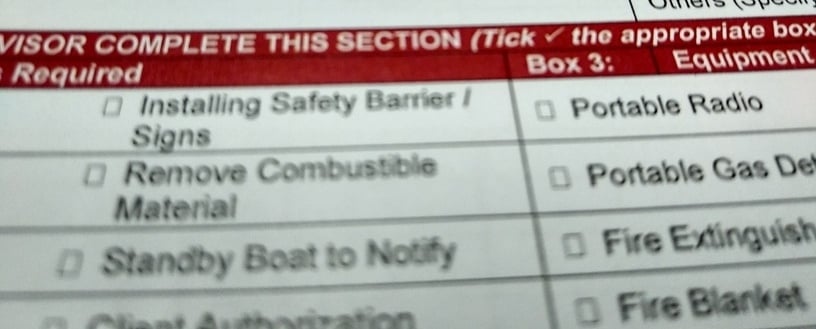It's no secret that OSHA visits always get everyone whispering about what could go or has gone wrong. Fines are a real threat to a business that cares about both reputation and bottom line. But if the day-to-day operations of your facility are in order, and you know your standards, visits don't need to be the stress factor they so often are. How can you begin eliminating OSHA fines before your next visit?

What's Going to Happen?
There's no exact science to ridding your facility of possible violations, but there are two pieces of information that will help you in any audit scenario:
A) What the regulating body looks for
B) What other companies are doing wrong
With regard to the first, data sheets are a hot topic. You need data sheets for all sorts of materials, from cleaning chemicals to whiteout. And their importance is two-fold: not only do these sheets actually help you respond to an on-site incident, but they also give the right impression: you're prepared, you have your ducks in a row, and you aren't missing the important stuff.
Knowing what other companies are doing wrong can also help you understand where OSHA is likely to look for hazards.
For the latest full year of data, 2015, OSHA's top 10 most frequently-cited violations were:
1. 1926.501 – Fall Protection (C)
2. 1910.1200 – Hazard Communication
3. 1926.451 – Scaffolding (C)
4. 1910.134 – Respiratory Protection
5. 1910.147 – Lockout/Tagout
6. 1910.178 – Powered Industrial Trucks
7. 1926.1053 – Ladders (C)
8. 1910.305 – Electrical, Wiring Methods
9. 1910.212 – Machine Guarding
10. 1910.303 – Electrical, General Requirements
(C) = Construction standard
Focus your attention on these common failures first. By focusing on what's most likely to happen, you can knock down high-ticket items while also becoming aware of possible issues in related areas. Now let's dive into the rest of our tips for keeping fines miles away from your facility.
6 Tips for Eliminating OSHA Fines
There are lots of ways your can work toward heightened attention to safety and health and therefore, fewer standards violations. From adding signage to incentivizing safety, from daily equipment maintenance to creating a full compliance department, your options are varied and many. The following are just a few ways you can begin kicking fines to the curb:
Lead by Example
Leading by example means you always wear the required footwear, perform your daily checks and immediately write up incidents. But it goes beyond that. You also need to hold yourself just as accountable for health and safety as you hold the rest of your organization. If you knock out a sprinkler that you should have checked for, well, guess what? It's time to write yourself up. It could bruise your ego, but instead use a mistake as a teaching moment for your team.
Over time, your actions will set a clear example for any incoming hires and for long-term employees; similar, compliant behavior will reduce your chances of getting a fine.
Engage Employees
Training doesn't have to be all video or all reading. Sometimes people learn best in the field. Consider offering training in various formats, including on-the-job training, so every learning style is equally represented.
Embracing this concept will help you see where multiple training and testing formats are critical. For instance, if you train a forklift operator only in theory, and they pass a written test, that doesn't mean they don't have to practice before hopping on a piece of equipment and taking off across the floor. A driving test will, of course, be necessary.
And don't feel like you have to keep training lighthearted, either. You know as well as we do that safety is serious business, so feel free to use some real-world examples — even if they may be gruesome — in your teaching.
Finally, conduct monthly safety meetings, so everyone stays engaged on a regular basis.
Divide and Conquer
Speaking of training, it's also important to split up responsibilities and train others on how to be accountable for certain tasks. Give knowledge to your group leaders, so they're empowered to make this work part of their everyday routines. If you cannot check everyone's footwear on a daily basis, train someone to do that job, and make sure they know how to record their results. That brings us to our next tip.
Record It
Write. It. Down. It doesn't matter what the incident is — keeping a record is better than not. From daily machinery checklists to data sheets, from employee safety records to certifications, keep everything you can, and keep it organized.
Go by the Book
That last tip is made much easier when you have a clearly documented set of rules and regulations, and you always live up to what they prescribe. If your written rule is that one standard violation = one write up, then write violators up, every time, without fail. Playing by the rules will go a long way toward making sure you avoid fines.
And finally...
Your Facility Should Reflect and Promote Safety
Putting in lanes for pedestrians and separate lanes for forklifts will not only make your facility look beautiful, but it will also show that you care about safety. With the right facility design and the right products to assist the design, your layout and the general cleanliness of your site can both encourage safety in the long-term and prevent accidents in the short-term.
Do you have any other tips for avoiding OSHA fines and keeping your facility safe? Share them in a comment!




